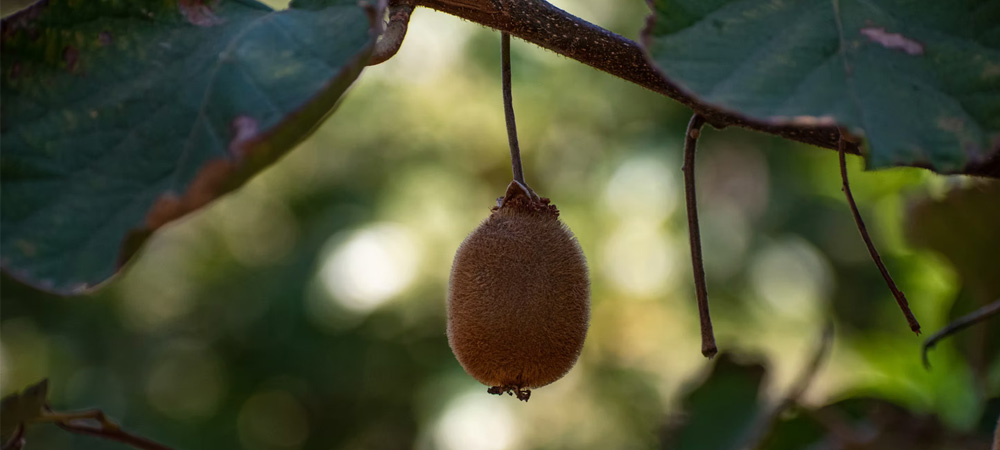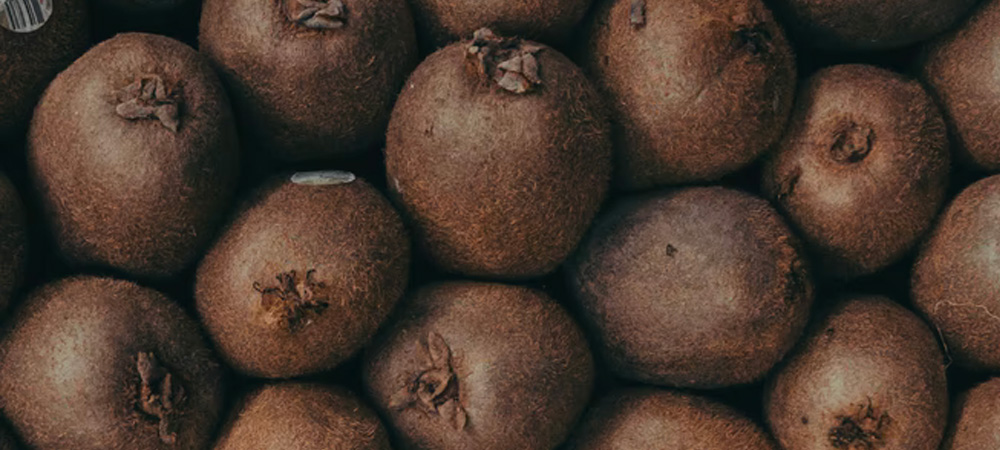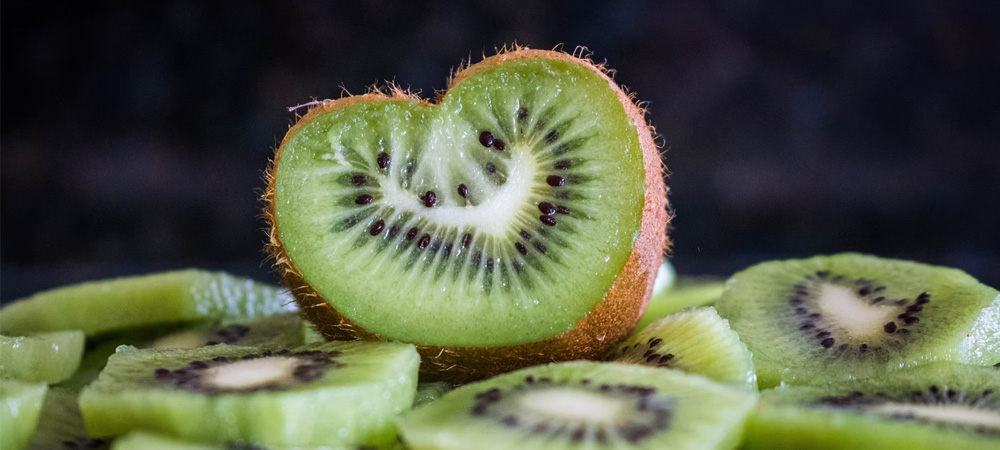How to Grow Kiwi Fruit in a Greenhouse

If you enjoy growing fruit, consider giving kiwi a try. Kiwi is easier to grow than you think. It is also delicious and a great source of vitamin C. The botanical name for kiwi fruit is Actinidia deliciosa.
Kiwi plants grow slowly and require a lot of space. You will want to leave three to three and a half meters (10-15 feet) of space between each plant.
You will need to have some patience if you are planning to grow kiwi fruit as the plants don’t start producing fruit for three or four years after planting!
Kiwi plants do best if they are planted in a greenhouse. A greenhouse is a structure that will provide shelter and protect your plants from inclement weather such as freezing rain, hail, strong winds or severe cold.
Provided you have a large enough space to grow several kiwi plants you will need to plant both male and female varieties in a ratio of one male for every eight female plants. This will allow for pollination and fruit production. If you only have a small space, one self-fertile kiwi plant will work.
Need more space? Browse our large greenhouses here, all available with free UK delivery.
Which Types of Kiwi Fruit Should Your Grow?
It is important to know that the different varieties of kiwi will grow better in some climates as compared to others. For example, Arctic kiwis will grow in cold winter regions while some other varieties will only grow where it is warm and sunny. The skin of the different varieties of kiwi fruit also varies in color, texture and whether or not it is edible.

It is essential to choose the correct kiwi fruit variety for your climate. Ask at your local garden centre for advice on which varieties of kiwi will work best in your garden. The following guide will give you some basic information about each of the varieties of kiwi plant.
FUZZY KIWIS
Fuzzy kiwis are the fruit you know and love. This is the type with the fuzzy brown skin and rich green on the inside that you pick up at your local grocery store. The size of this kiwi fruit is comparable to an egg. Fuzzy kiwis are nutritious and delicious!
ARCTIC KIWIS
Arctic kiwi plants are a great option if you live in a cold area. Arctic kiwis are just as delicious as the other kiwi fruits and the white and pink leaves will look beautiful in your garden.
HARDY KIWIS
Hardy kiwis can be grown in a colder climate. They are hairless and the skin is green. They are smaller than the fuzzy kiwi, closer to the size of a large grape. These have the same nutritional value as the fuzzy kiwi and taste amazing.
GOLDEN KIWIS
As the name suggests the skin of this kiwi fruit is a lovely golden colour. The flesh ranges from bright yellow to intense green. Golden kiwis are high in vitamin C and fibre.
SILVER VINE KIWIS
This variety of kiwi grows and climbs quickly. The leaves of this plant are heart-shaped with silvery-white tips. The fruit it produces is much smaller and not as sweet as fuzzy kiwi fruit. This type of kiwi is often used in Asia for its medicinal qualities.
PURPLE KIWIS
If you are looking for a stunning addition to your garden, consider the purple kiwi. The skin is a beautiful deep red colour. Purple kiwis are often grown for their aesthetic appeal.
KIWI BERRIES
Kiwi berries are much smaller than other kiwi fruit and are always eaten with the skin on. Kiwi berries are also known as baby kiwi, grape kiwi and dessert kiwi. Kiwi berries have a sweet taste and are rich in vitamins C and E.

When Should You Plant Kiwi Fruit?
Outdoor kiwi plants should be planted when the weather is warmer in the later spring. If you are planting in a greenhouse, you can plant earlier as there is no risk of frost.
Remember, it takes three or four years for a kiwi plant to start producing fruit.
Benefits of Growing Kiwi in a Greenhouse
A greenhouse will shelter and protect your kiwi plants from harsh weather conditions such as strong winds, hail, heavy rain, snow and frost. If you live in a colder climate with some severe weather conditions a greenhouse will allow you to grow kiwi plants successfully.
Many people choose to start their kiwi plants in a container inside the greenhouse but when they mature and can handle a little bit of inclement weather they are moved into the garden. Kiwi plants can also be kept in the greenhouse year-round.
A greenhouse will allow you to start growing your kiwi plants earlier. The protection a greenhouse offers means that your growing season will be much longer.
Another advantage of growing your plants in a greenhouse is that pest and disease problems can be minimized with the ability to control temperature and humidity. Plants will remain healthy and thriving even in very dry, cold or harsh weather.
Controlling the Growing Environment in Your Greenhouse
Providing an appropriate level of humidity will help your plants to grow and thrive. Similarly, adjusting the greenhouse temperature to an ideal level is a second important factor that will keep your plants happily producing fruit.
You will see that the performance of kiwi vines increases as you carefully monitor the humidity and temperature within your greenhouse. Additionally, the level of humidity in your greenhouse will affect the temperature and vice versa. The following information will help you decide how to control the humidity and temperature in your greenhouse in order to keep your plants healthy.
- The use of fans in your greenhouse is essential. Fans will cool your greenhouse and decrease the level of humidity. There are two types of fans to consider.; they both effectively allow more consistent airflow within your greenhouse. Horizontal airflow fans are mounted on the roof and sides of your greenhouse. The second type of fan is the extraction fan. This fan cools the greenhouse and decreases humidity.
- You can use a weather station to carefully monitor the temperature, rain levels, solar levels, humidity, and wind.
- Installing vents in your greenhouse is a simple way to increase the airflow inside the greenhouse.
- Using a garden hose to wet the walls of your greenhouse can help to reduce the temperature inside the greenhouse.
- Placing shade cloths over your greenhouse is another effective way to cool your greenhouse. A shade cloth is basically a curtain that covers your greenhouse and blocks some of the sun's potentially damaging rays.
- Using a radiant heater can be an effective way of warming your greenhouse so that your kiwi vines don’t get too cold.
Related article: How to heat your greenhouse in winter.

How to Grow Kiwi Fruit in Your Greenhouse Step-by-Step
Kiwi plants can be easily grown from seed. You simply need to buy the seeds from your local garden store or remove them from fresh kiwi fruit. Alternatively, you can purchase young kiwi plants that have already been started. Here are some easy steps to help you grow your very own kiwi plants!
1. KIWI SEEDS
There are two ways of getting the kiwi seeds required to grow kiwi plants in a greenhouse.
- All gardening stores and nurseries will carry a variety of kiwi seeds. Please note, if you buy organic kiwi seeds you will get a hardy variety of kiwi.
- If you want to use the seed from the fresh kiwi you have purchased from the grocery store, simply remove the seeds and wash them with water.
2. Germinate Seeds
Take your kiwi seeds and carefully place them in a damp paper towel. Put the paper towel containing your seeds into a resealable plastic bag. Find a warm place indoors to leave the seeds, perhaps by a sunny window. Check the seeds a couple of times a day and keep the paper towel consistently moist. The humidity will help the seeds to germinate.
3. Plant
Once the seeds have sprouted carefully remove any seeds that are not sprouting. Fill a small pot with seed starter potting mix. Rip a bit of the paper towel that has about three or four of the strong seeds clinging to it, plant these seeds with the paper towel in the potting mix. Do this for each kiwi vine you want to plant.
4. Water and Give Light
Give your new plants a generous amount of water. Find a place in your greenhouse that has an abundance of light to place your little plant pots. When your kiwi vines get big enough carefully transfer them to a larger pot.
Some tips to keep note of:
The climate you live in will affect the ability of your plant to grow. It is essential to choose the right variety of kiwi fruit. You can ask any local nurser for a variety that will grow easily in your climate.
Your kiwi plants will require both male and female plants to produce fruit.
Kiwi plants produce fragrant flowers that may be different colours depending on the variety. Fruit production occurs in the late fall.
Your kiwi plants need a lot of sunlight. They should not be subjected to frost or very harsh weather.
Use a liquid phosphorus-rich fertilizer on your new kiwi plants. The fertilizer will increase growth and production of fruits. Adding compost tea to the soil can also help your plants grow.
Do Kiwi Fruits Self Pollinate?
It is possible to find a variety of kiwi fruit that is self-fertile. If you have this variety, you don’t need both the male and female varieties. You can grow only one kiwi plant and it will produce fruit on its own.
If you don’t have the self-fertile variety, female Kiwi fruit will need a male partner in order to produce fruit.
Honeybees and wind are helpful for pollinating your kiwi fruits.
Kiwi Fruit Pests
There are several pests that affect kiwi fruit. Keep an eye out for these pests so you can protect your plants. Here are some of the most common pests that affect kiwi fruit plants.
Spider Mites
It may be difficult to know if your plants are being infected with spider mites because they are invisible to the naked eye. If you suspect spider mites, insecticidal soap spray or neem oil is the best remedy to control these nasty pests.
Boxelder Bugs
Boxelder bugs are easy to spot because of the unique narrow red lines on their backs. These bugs are usually found in coastal areas around and on trees. Small populations of Boxelder bugs are relatively harmless but large numbers of these bugs can cause plants to look distorted.
Nematodes
Nematodes are small worms, they are so small that you would need a microscope to see them, but they tend to attack in large numbers and can seriously damage your plants. Keeping the soil well-drained can help control their population.
Thrips
These pests are tiny, but you can easily see them. If the leaves of your kiwi plants look damaged check carefully for these slender black insects. They disrupt the growth of the plants by sucking the juice from them. A strong stream of water or insecticidal spray can help keep them under control.
Japanese Beetle
If you see a bug in your growing space with an iridescent green sheen you have likely found a Japanese beetle. They can be very harmful to your plants. You can eliminate them using an insecticide.
Should Your Prune and Train Kiwi Plants?
Prune your kiwi vines vigorously in winter and summer to control excess growth. Pruning is an important component of growing kiwi plants.
In the winter prune aggressively - cut back to about one-quarter of the oldest laterals. This pruning practice will encourage new growth each year.
Prune again in the summer months (May-June). Taking off excess growth will help your plants produce healthy fruits.
You will want to encourage your kiwi vines to grow upright and climb straight. You can do this by training the vine. Tie leading shoots to a cane so that it remains upright. Ensure there is consistent and healthy airflow in the area you are growing your kiwi plants.
Harvesting Kiwi Fruit
Kiwi fruit will mature in September or October.
Observe and feel your kiwi fruits. If they are brown and soft, they are ready to be harvested. The best time for harvesting the Kiwi fruit is when they are soft and ready to be eaten. The colour of the fruit should be brown when you pick them.
If you need to harvest your kiwi early because of a frost risk, store them in a cool dry place for six weeks or until they are ready to eat.
Storing Kiwi Fruit
Kiwi fruit can be stored in the refrigerator for up to six weeks.
Kiwi fruit can be stored for a longer period of time (up to three months) in the freezer if they are in plastic freezer bags.
Related Articles
We have a wide range of growing related articles on our blog, here are some to read next:
 Author:
Author: